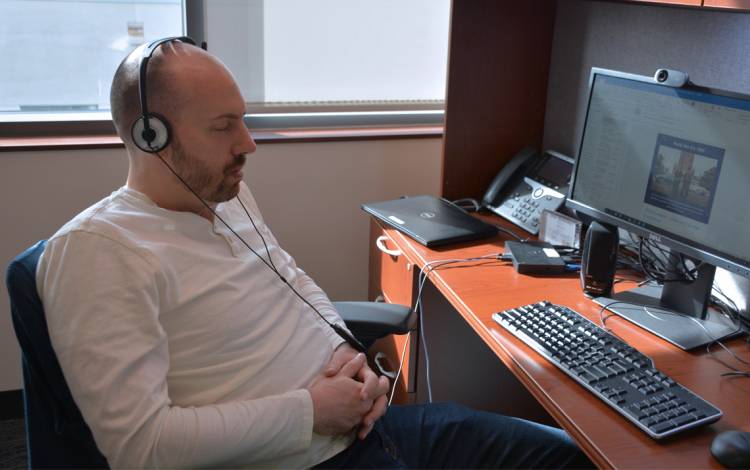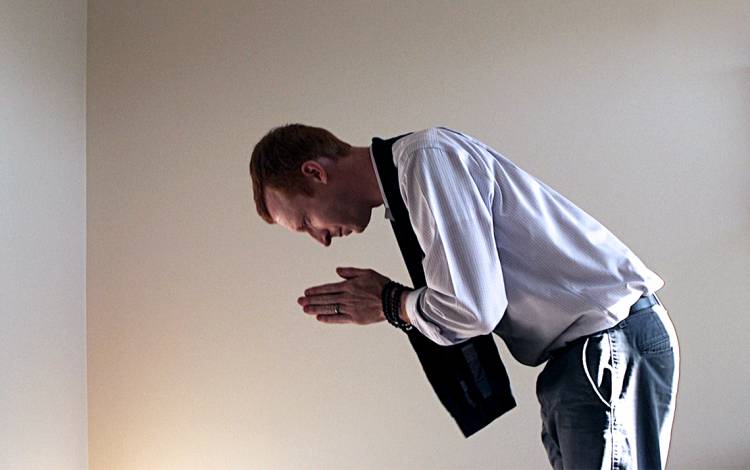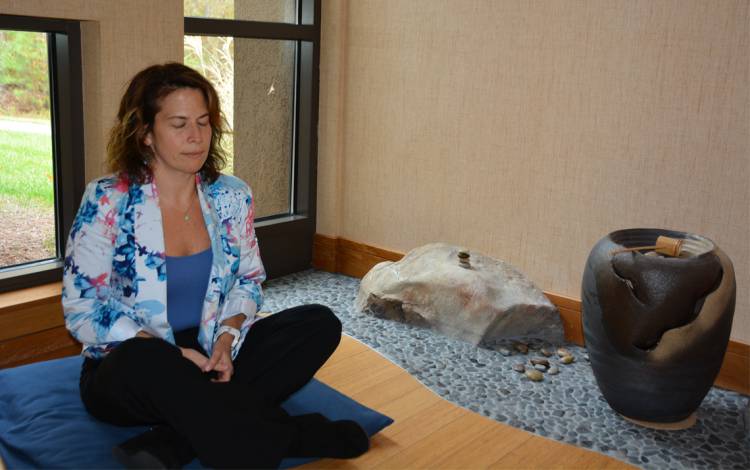5 Easy Ways to Start Meditating
Duke experts offer advice to help you start and sustain a meditation practice

Rather than fight an energy dip with caffeine in the afternoon, Daniel Hatch closes his eyes and puts on headphones to block noise. He focuses on breathing deeply through his nose and out of his mouth for five minutes.
 “For me, I’ve found that meditating in the afternoon is almost like taking a nap,” said Hatch, a biostatistician for the Duke School of Nursing. “I feel less anxious afterward. It calms me down and I feel refocused.”
“For me, I’ve found that meditating in the afternoon is almost like taking a nap,” said Hatch, a biostatistician for the Duke School of Nursing. “I feel less anxious afterward. It calms me down and I feel refocused.”
Meditation, the practice of observing your thoughts and feelings without judgment, can be a beneficial habit for reducing anxiety, depression and high blood pressure and improving sleep, according to the National Institution for Health’s National Center for Complementary and Integrative Health.
Focusing on your breathing is one way to be in the moment. Take a look at four other pieces of advice from Duke University and Health System experts on starting your own meditation practice.
Start short
For two decades, Duke neurosurgeon Patrick Codd has practiced Zen, a Buddhist form that holds meditation at the core of its philosophy.
He suggests starting with two minutes of meditation each day and increasing to five, then 10 minutes, as you’re able to complete each length of time. Codd started meditating in five-minute increments and now does it multiple times a week. He sits on a comfortable cushion in a quiet room and turns his attention toward counting his breaths or watching what arises in the body and mind for about 30 minutes on average.
“You’ll get frustrated and give up if you over challenge yourself,” Codd said. “Know that it’s going to take some practice and kindness toward yourself. Any little bit can count.”
Pick a designated space

When Jocelyn Weiss needs to focus energy, she takes a short walk from her office to a Duke Integrative Medicine meditation room, where she sits on a cushion, closes her eyes and takes deep breaths.
“It’s good to have an area specifically for meditation,” said Weiss, Duke Integrative Medicine’s education and training coordinator. “It’s like avoiding your bed for anything but sleep. You want your mind and body to know the space is designated to meditate.”
At home, Weiss uses a corner in her bedroom for meditation. She sits on a cushion and places incense and flowers on a low table.
“Create a space that makes you comfortable and is free of distractions, offering the greatest opportunity to focus on your practice,” Weiss said. “If you need back support, you can lean against a wall. If you like certain aromas, then have them nearby.”
Find a community

By her sophomore year at Duke, Natasha Gupta had a hard time shaking anxiety about balancing coursework and social pursuits.
After years of ignoring her dad’s advice to meditate, she gave the practice a shot with Duke University’s student-led Buddhist Meditation Community and fell in love with meditation.
“I felt calmer and like I had more space in my head,” said Gupta, now a senior majoring in economics and English. “Meditation helped me come to terms with my emotions.”
Gupta leads one of two weekly guided meditation classes at the Student Wellness Center. The classes continue through the academic year and are open to all Duke community members. Check the Student Wellness Center’s website for updates on time and location.
Gupta said finding a community was essential to her practice. It gave her a designated time to meditate each week and friends to discuss her struggles and successes.
“They helped me get started,” she said. “Now, they hold me accountable.”
Use an app

Sometimes Jocelyn Weiss needs a little assistance to get into the right headspace for meditation.
She gets help from InsightTimer, a free app for Apple and Android users that has about 30,000 guided meditation programs in a range of topics from helping the user prepare for sleep, to feeling more gratitude to dealing with stress.
Headspace is also available for a free trial on Apple and Android software. The app has guided meditation and mindfulness sessions to help with focus, anxiety, sport performance, sleep and more.
“The app can be that little push I need to get me going,” Weiss said.
WATCH our short video to learn about the benefits of practicing mindfulness.
Have a story idea or news to share? Share it with Working@Duke.